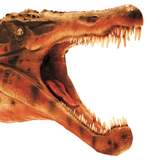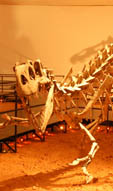
EDUARDO CESARBrazilian finding: skull of a spinosaurid reconstituted from fossils found in Maranhão EDUARDO CESAR
“I set up exhibitions to take my revenge on school”, shoots Luiz Eduardo Anelli, of the University of São Paulo (USP), the curator of the most wide-ranging display shown in Brazil of fossils of dinosaurs and other animals that inhabited the Earth in the last 700 million years: Dinos in the Oca, on show until April 30 in Ibirapuera Park, in the city of São Paulo. “All my life I’ve seen school as a punishment, a place where teaching is not done in a fun way.” Determined to prove that it does not have to be like that, Anelli spent the last few months of 2005 divided between his researches at USP’s Geosciences Institute and hours and hours of meetings with the team of Emilio Kalil, from the GabineteCultura agency, the organizer of this R$ 7 million exhibition.
Under the concrete dome designed by Oscar Niemeyer, the São Paulo paleontologist managed to bring together some of the most important dinosaurs from the United States, Africa, China, Argentina and, of course, Brazil. The largest of them is the Jobaria tiguidensis, a herbivore 22 meters long from head to tail that lived 135 million years ago. The team of the American paleontologist Paul Sereno, from the University of Chicago, recovered its almost complete skeleton in 1997 in the sands of the desert in Niger, in the central region of Africa. From the carnivorous predators, on display are the 1.5 meter-long skull of the feared and popular Tyrannosaurus rex, which 70 million years ago inhabited the territory where North America is today, and the skull of another animal even larger: the Carcharodontosaurus saharicus, whose skeleton was unearthed in 1995 by Sereno’s team in Morocco.
Contrary to what many may think, the dinosaurs were not always so big. When they appeared on Earth about 230 million years ago, they were relatively small. One example is the Eoraptor lunensis, a carnivorous dinosaur that measured only 1 meter from its head to the tip of its tail and walked on its hind legs. Its fossil, found in the northwestern region of Argentina, indicates that it lived 228 million years ago, in the geological period called Triassic. Another precursor of the dinosaurs that is in the Oca is the Staurikosaurus pricei, a carnivore of almost 2.5 meters in length. Discovered in 1937 in the region of Santa Maria, in the interior of Rio Grande do Sul, the Staurikosaurus is one of the oldest dinosaur fossils ever found in Brazil.
But it is not the only one. In the part of the exhibition dedicated to the Brazilian representatives, it is possible to see the reconstitution of the Unaysaurus tolentinoi – another grandfather of the dinosaurs, which lived 1 million years later than the Staurikosaurus – and the Santanaraptor placidus, a 1.5 meter predator whose 110 million year old fossil was found in Chapada do Araripe, in the interior of Ceará.
It was from this region, rich in fossils of an age between 120 and 110 million years, that there came the petrified bones of other animals exhibited at the Oca such as fish fossils and the pterosaurs – flying reptiles related to the dinosaurs – Anhanguera piscator, one of the biggest ever discovered in Brazil, with 5 meters from one wingtip to the other, and Thalassodromeus sethi, with one of the largest osseous crests ever observed in vertebrates. Far younger than these animals, but no less impressive, is the primitive crocodile Purussaurus brasiliensis, which between 8 million and 6.5 million years ago inhabited a marshy region of what is today the Brazilian Amazon. Regarded as the largest crocodile ever found – larger even than the T. rex –, the Purussaurus was almost 15 meters in length.

EDUARDO CESARAfrovenator EDUARDO CESAR
Certainly the most grandiose exhibition ever set up by Anelli, Dinos in the Oca is an addition to others held in recent years at USP’s Geosciences Institute and at Estação Ciência [Science Station], in São Paulo. A specialist in primitive mollusks, the 41-year-old paleontologist discovered his vocation as a populizer of science by chance, in 1987, when he was finishing his undergraduate course in biology at the State University of Londrina, in Paraná. “I had no idea of what I was going to do on finishing the course, and I looked for an attachment at the paleontology laboratory of Professor André Celligoi”, says Anelli. “There I saw several fossils, which I decided to clean, catalog and exhibit at the university.” From then until now he has not stopped taking the skeletons out of the drawers and looking for ways of using them to teach the evolutionary history of the planet in a fun manner. From that perspective, one of his greatest finds was perhaps an empty room at USP’s Geosciences Institute. There Anelli found, in 1998, the necessary space for expanding the access to USP’s fossil collection: he created the Replica Workshop, which reproduces in plastic material identical copies of the original petrified bones that, according to the paleontologist, can even be used to carry out research. “It’s like reading a copy of a book”, he says.
In these almost ten years of the workshop’s activity, schools from various Brazilian states have bought about 17 thousand replicas to teach paleontology and evolution. This work of popularizing science is possible, in part, because of the agreement that the paleontologist from USP has with his undergraduate and postgraduate students: their work must not remain hidden away, nor circulate only amongst researchers, in the form of scientific articles. Some of them have now been transformed into children’s books, like Getting to know the dinosaurs: stories brought together, Coloring the history of life, and Extinction is forever: the history of the giant mammals of South America, adopted as extra educational material by the state secretariats for education of São Paulo and Bahia. The reason for choosing children and adolescents as his target public is obvious: “It is at this stage that the interest for the world is awakened”, says the researcher. “That is why I write the books that I would like to have read when a child.”
Republish